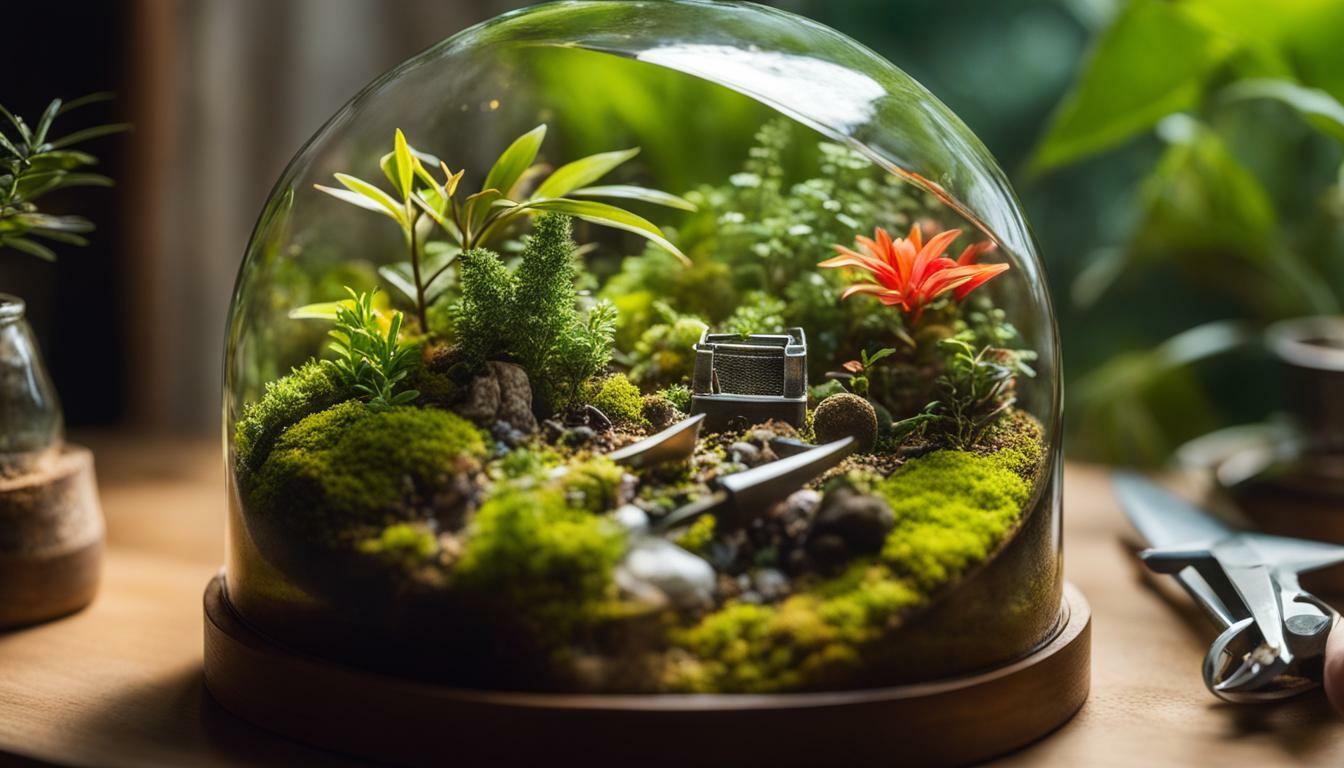Terrarium care maintenance is crucial for the health and longevity of your mini-garden. Whether you’re new to terrariums or have some experience, these tips will help you ensure that your terrarium thrives. From checking humidity levels to trimming overgrown plants, these maintenance practices will keep your terrarium looking beautiful and vibrant.
Key Takeaways:
- Check humidity levels in your terrarium to ensure proper moisture.
- Avoid overwatering and use a mister or spray bottle for watering.
- Provide bright indirect light and avoid direct sunlight.
- Prevent and address mold growth with proper airflow and natural remedies.
- Promptly remove rotting plants to maintain a healthy balance.
- Trim overgrown plants to prevent light obstruction and maintain harmony.
- Clean the terrarium glass regularly for optimal light transmission.
Remember to consider the specific needs of each plant in your terrarium and make any necessary adjustments to your care routine. By following these essential maintenance tips, you can enjoy a thriving and beautiful terrarium for years to come.
Checking Humidity and Moisture Levels
Maintaining proper humidity levels is essential for the overall well-being of your terrarium. The moisture within the enclosed environment helps create a microclimate that mimics the natural conditions required for the plants to thrive. Monitoring humidity is crucial in ensuring that your terrarium remains a suitable habitat for the plants.
To check the humidity levels, observe the condensation on the glass. If there is a significant amount of condensation, it indicates high humidity. On the other hand, if there is no condensation, it may indicate low humidity. Striking a balance is important, as excessive humidity can lead to mold growth, while low humidity can cause the plants to wither and dry out.
When it comes to watering your terrarium, it’s important to strike the right balance. Overwatering can lead to stagnant water, which creates a breeding ground for mold and can harm the plants. Instead, use a mister or spray bottle to water your terrarium evenly and in small amounts. This allows you to provide moisture without overdoing it.
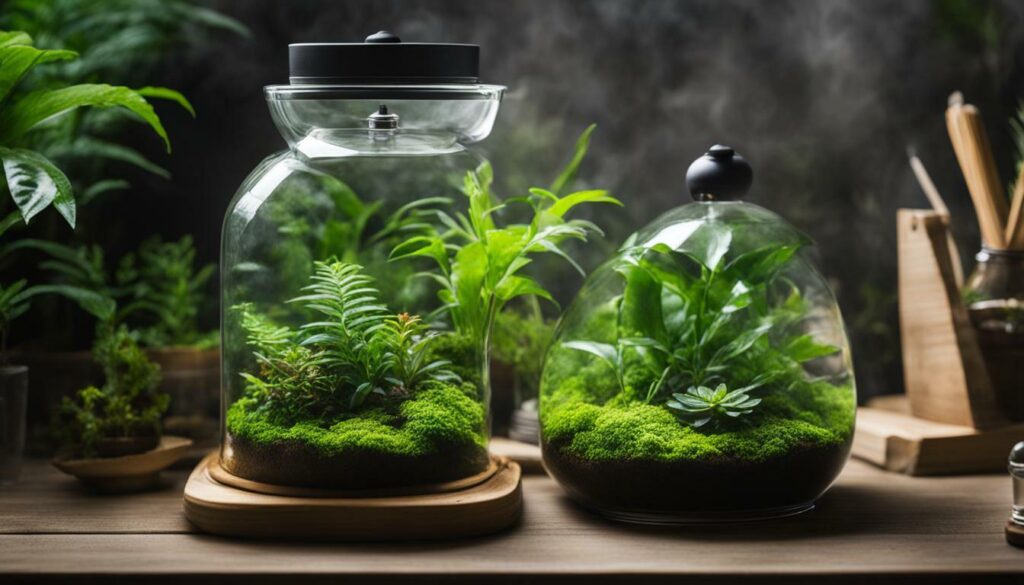
Regularly monitoring the humidity levels and providing adequate moisture will help create a healthy and thriving terrarium environment for your plants to flourish.
| Common Mistakes | Best Practices |
|---|---|
| Overwatering the terrarium, leading to stagnant water and mold growth | Use a mister or spray bottle to water evenly and in small amounts |
| Not checking humidity levels, resulting in imbalanced moisture conditions | Observe condensation on the glass to gauge humidity levels |
| Neglecting to provide additional moisture when necessary | Mist the terrarium with water if condensation is low or absent |
Expert Tip:
“Maintaining the right humidity levels is crucial for the success of your terrarium. It’s important to strike a balance and avoid extreme conditions that can harm your plants.”
By following these guidelines, you will be able to maintain optimal humidity levels in your terrarium, ensuring the well-being and growth of your plants.
Providing the Right Amount of Light
Light plays a crucial role in the growth and development of terrarium plants; therefore, it is crucial to provide the right amount of light. Direct sunlight can be harsh and may lead to burnt leaves, so it’s best to avoid placing your terrarium in direct sunlight. Instead, opt for bright indirect light, which mimics the dappled sunlight found in natural environments.
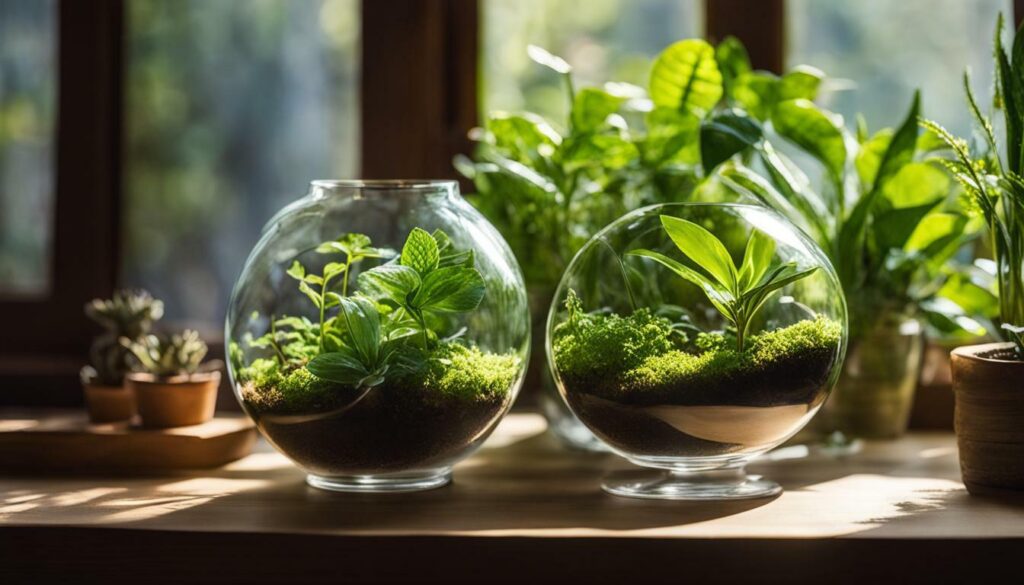
“Bright indirect light is usually ideal for most terrarium plants.”
One way to determine if your terrarium is receiving the appropriate amount of light is by observing the color of the plants. Lush green foliage indicates sufficient light, while pale or yellowing leaves may suggest inadequate light. Consider placing your terrarium near a north or east-facing window to provide the right amount of natural light.
Adjusting Light Intensity
If you notice that your terrarium plants are not thriving, you can adjust the light intensity by manipulating the distance between the light source and the terrarium. Lowering the light closer to the plants will provide more intense light, while raising it will reduce the intensity. Keep in mind that different plant species have varying light requirements, so it’s essential to research the specific needs of the plants in your terrarium.
By carefully monitoring and adjusting the light exposure of your terrarium, you can create an environment that promotes healthy plant growth. Remember to regularly evaluate the condition of your plants to ensure they are receiving the optimal amount of light.
Dealing with Mold and Preventing Growth
Mold can be a common challenge in terrariums; here’s how to effectively manage and prevent its growth. One of the essential steps in preventing mold is to improve airflow within the terrarium. This can be done by opening up the lid for a short period each day to allow fresh air to circulate. Additionally, keeping the terrarium in a well-ventilated area can help reduce the risk of mold formation.
Another effective method for dealing with mold is using natural remedies. Hydrogen peroxide or chamomile tea can be applied to small patches of mold to combat its growth. Simply dilute hydrogen peroxide with water or brew chamomile tea and spray it directly onto the affected areas. These natural solutions not only help eliminate mold but are also safe for your plants.
Introducing beneficial organisms, such as springtails, to your terrarium can also help prevent mold growth. Springtails are tiny arthropods that feed on decaying organic matter, including mold. They can be purchased from pet stores or online retailers specializing in terrarium supplies. By introducing springtails into your terrarium, you create a natural balance that reduces the likelihood of mold formation.
To further assist you in managing mold growth, here is a table summarizing the key steps:
| Steps to Manage Mold Growth | |
|---|---|
| Improve airflow by opening the lid daily | 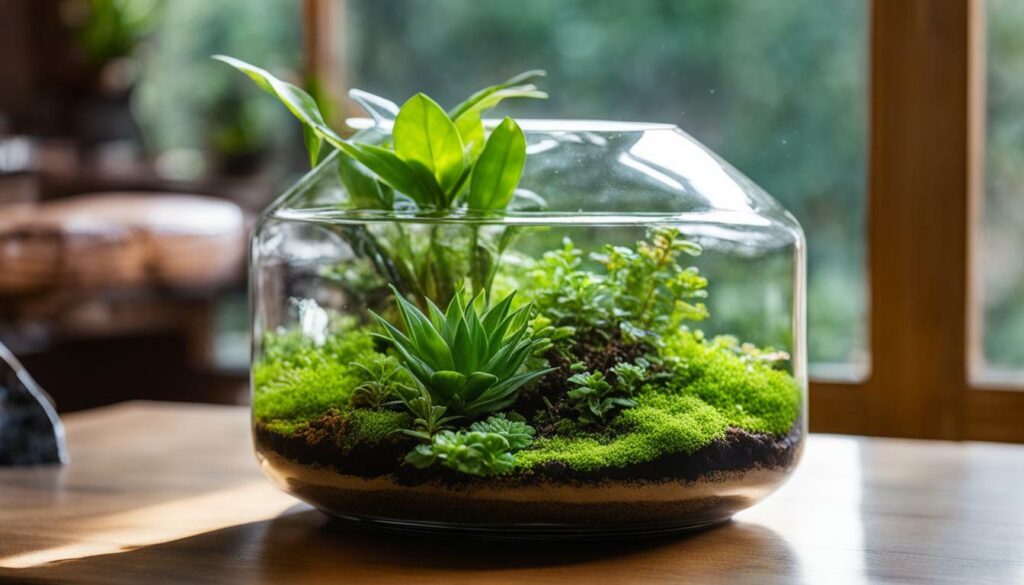 |
| Use natural remedies like hydrogen peroxide or chamomile tea | |
| Introduce beneficial organisms like springtails |
By following these tips and being proactive in preventing mold, you can ensure a healthy and thriving terrarium environment for your plants. Remember to monitor your terrarium regularly and address any signs of mold promptly to maintain the beauty and longevity of your mini-garden.
Removing Rotting Plants and Maintaining Balance
Rotting plants can disrupt the delicate balance of your terrarium; here’s how to address this issue. When you notice a plant starting to decay, take immediate action to prevent further damage and maintain a healthy environment for your other plants. First, carefully remove the rotting plant from the terrarium. Use sterilized tools to cut away the affected parts, ensuring that you don’t accidentally spread any diseases. Dispose of the removed plant material properly to avoid introducing any pathogens back into the terrarium.
After removing the rotting plant, assess the overall balance of your terrarium. If the decay was extensive, it may have affected the moisture levels and created an imbalance. Check the humidity and moisture levels to ensure they are within the appropriate range for your terrarium. Adjust the watering schedule accordingly, ensuring that you don’t overwater or underwater the remaining plants. Observing how the other plants are responding can provide valuable insights into the overall health of your terrarium.
Additionally, consider using a natural remedy, such as activated charcoal, to absorb any remaining toxins that may have been released by the rotting plant. Activated charcoal can help cleanse the terrarium and restore a healthy balance. Introduce beneficial organisms, like springtails or isopods, to help break down organic matter and prevent future mold or decay. These tiny organisms can contribute to the ecosystem of your terrarium, promoting a cleaner and healthier environment for your plants.
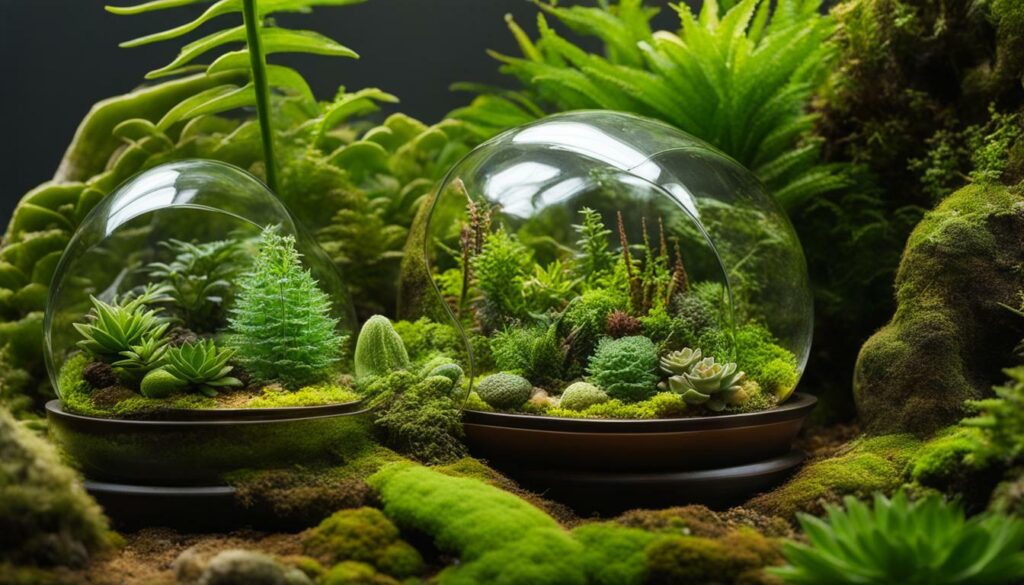
- Carefully remove the rotting plant with sterilized tools
- Dispose of the removed plant material properly
- Assess the overall balance of the terrarium
- Check and adjust humidity and moisture levels
- Consider using activated charcoal to cleanse the terrarium
- Introduce beneficial organisms to prevent future mold or decay
By promptly addressing rotting plants in your terrarium and maintaining a healthy balance, you can ensure the longevity and beauty of your miniature garden. Regularly inspecting your terrarium and taking proactive measures will help create a thriving environment for your plants to flourish.
| Related Articles | References |
|---|---|
Terrarium Care Guide: Tips for Beginners |
1. Smith, J. (2022). The Art of Terrarium Gardening. New York: Green Publishing. |
Preventing Mold in Terrariums: Tips and Tricks |
2. Johnson, L. (2021). Terrarium Troubleshooting 101. Garden Gazette, 25(3), 45-52. |
Trimming Overgrown Plants
Overgrown plants can hinder the growth of other plants and compromise the aesthetics of your terrarium; learn how to keep them in check. Trimming overgrown plants not only ensures a harmonious appearance but also prevents light obstruction and promotes overall plant health. With proper techniques, you can easily manage the growth of your terrarium plants.
When trimming overgrown plants, start by identifying the areas that require pruning. Look for branches or leaves that are extending beyond the desired boundaries of your terrarium. You can use a pair of clean, sharp scissors or pruning shears to carefully trim these excess growths. Remember to work slowly and cautiously, focusing on maintaining a balanced and visually pleasing arrangement.
During the trimming process, it’s essential to consider the specific needs of each plant. Some plants may require regular pruning to prevent them from overpowering other plants, while others may need less frequent trimming. Additionally, you can manage the growth of certain plants by pruning their roots. This helps maintain a healthy root system and slows down their overall growth.
To avoid any damage to your terrarium plants, it’s crucial to maintain a sterile cutting tool. Clean your scissors or shears before and after each use to prevent the spread of diseases or pests. Additionally, make sure to remove any trimmed plant materials from the terrarium promptly.
| Trimming Overgrown Plants: | Tips for Success: |
|---|---|
| 1 | Identify overgrown areas and remove excess growth with clean, sharp scissors or pruning shears. |
| 2 | Consider the specific needs of each plant and adjust the trimming routine accordingly. |
| 3 | Prune plant roots to manage their growth and maintain a balanced terrarium. |
| 4 | Maintain a sterile cutting tool by cleaning it before and after each use. |
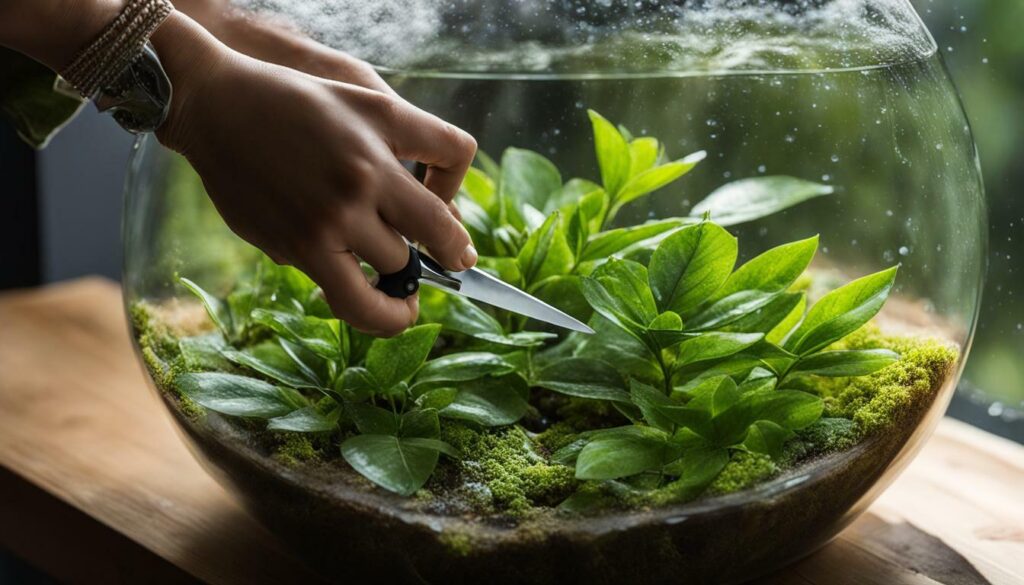
Regularly trimming overgrown plants is an essential part of terrarium care. It not only promotes the health and balance of your mini-garden but also enhances its overall beauty. By following these simple tips and understanding the specific needs of your plants, you can easily maintain a thriving and visually appealing terrarium.
Cleaning the Terrarium Glass
Clean terrarium glass is essential for maintaining a healthy and visually pleasing environment for your plants. Regular cleaning helps ensure optimal light transmission and prevents any obstruction that may hinder plant growth. Follow these simple steps to keep your terrarium glass sparkling clean:
- Start by removing any visible debris or dust from the glass surface. Use a soft, lint-free cloth or a feather duster to gently wipe away any loose particles.
- Prepare a cleaning solution by mixing equal parts of distilled water and white vinegar. This natural solution effectively removes dirt and residue without harming your plants.
- Dampen a clean cloth or sponge with the cleaning solution and gently wipe the interior and exterior surfaces of the terrarium glass. Ensure thorough coverage and pay special attention to any stubborn stains or marks.
- Rinse the glass with purified water to remove any vinegar residue. Avoid using tap water, as it may contain chemicals or minerals that could be harmful to your plants.
- Dry the glass thoroughly with a clean, lint-free cloth or allow it to air dry. This step is crucial to prevent streaks or water spots that can affect the clarity of your terrarium.
By following these cleaning tips, you can maintain a clear view of your miniature garden and provide your plants with the optimal light they need to thrive. Remember to clean your terrarium glass regularly to ensure the long-term health and beauty of your terrarium.
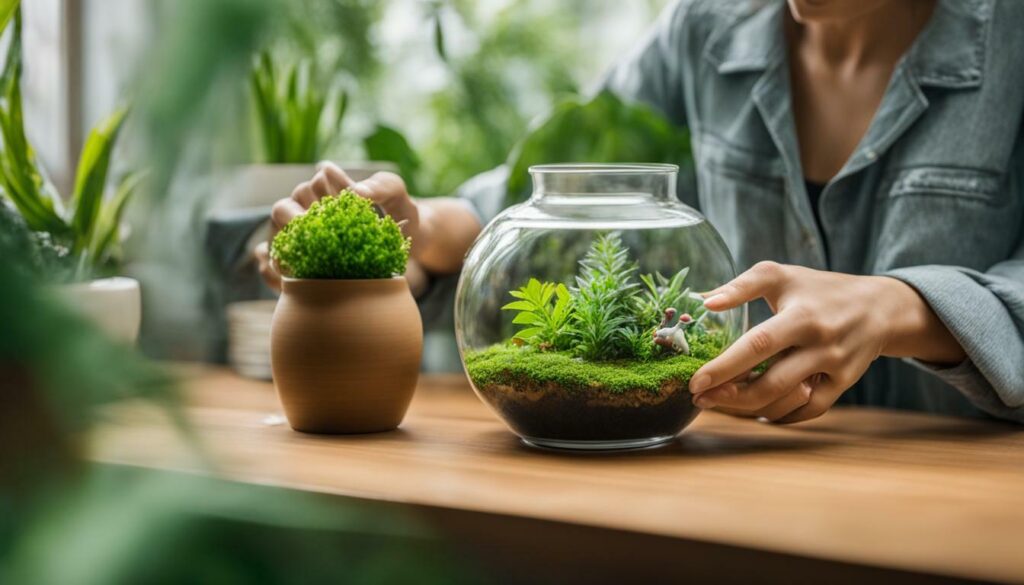
Individual Plant Care Considerations
Every plant in your terrarium has unique care requirements; here’s how to cater to their specific needs:
| Plant Type | Lighting | Watering | Temperature |
|---|---|---|---|
| Succulents and Cacti | Bright indirect light | Allow soil to dry before watering | Warm and dry |
| Tropical Plants | Bright indirect light | Keep soil evenly moist, but not waterlogged | Warm and humid |
| Mosses and Ferns | Low to medium indirect light | Mist with water to keep moist | Cool and moist |
| Air Plants | Bright indirect light | Soak in water once a week, mist in between | Warm and humid |
Remember to pay attention to each plant’s growth rate and adjust their care routine accordingly. Some plants may need more frequent trimming, while others may require less water or sunlight.
Additionally, be mindful of any signs of stress or disease in your plants. Yellowing leaves, fungal growth, or wilting can indicate underlying issues. Take appropriate action, such as adjusting lighting or addressing pest problems, to ensure the overall health of your terrarium.
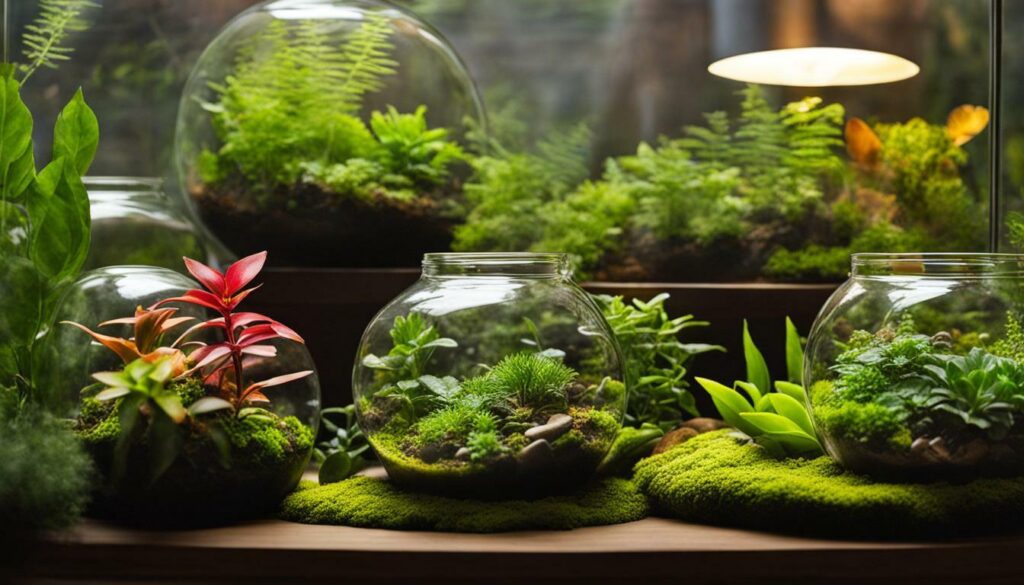
Incorporating a variety of plants in your terrarium not only adds visual interest but also creates a balanced ecosystem. By providing the right care for each plant species, you can enjoy a thriving and beautiful miniature garden.
What are the essential maintenance tips for beginners to care for a terrarium?
As a beginner, following an expert terrarium care guide is crucial for maintaining a healthy terrarium. Start by choosing the right container, soil, and plants. Regularly water and prune the plants as needed. Keep an eye on humidity levels and ensure the terrarium receives proper sunlight.
Conclusion
By following these essential terrarium care maintenance tips, you can ensure the longevity and thriving of your mini-garden.
Checking for humidity and maintaining proper moisture levels are crucial for a healthy terrarium. Look for condensation on the glass as an indicator of the right humidity. Be careful not to overwater your terrarium, using a misting or spraying technique instead.
Providing the right amount of light is key to the success of your terrarium. Avoid direct sunlight, as it can harm the plants. Bright indirect light is usually the ideal choice.
Mold can be a common problem in terrariums. Ensure good airflow by occasionally opening the lid. To combat small patches of mold, consider using hydrogen peroxide or natural remedies like chamomile tea. Adding beneficial organisms like springtails can help prevent mold growth.
Promptly remove any rotting plants from your terrarium to maintain a healthy balance and prevent mold. Additionally, trim overgrown plants to prevent them from obstructing light or taking over the terrarium. Remember that you can also prune the roots of plants to control their growth.
Regularly clean the terrarium glass, both inside and out, to allow proper light transmission and maintain a clear view of your mini-garden. Use a lint-free cloth and purified water to avoid harming the plants.
Lastly, keep in mind that individual plants may have specific care requirements. Pay attention to their needs and adjust your care routine accordingly. With proper maintenance and understanding of your terrarium, you can create a thriving and beautiful mini-garden.
FAQ
How do I check the humidity and moisture levels in my terrarium?
Look for condensation on the glass, as it is a good indicator of proper humidity levels. If there is too much condensation, it may be a sign of overwatering.
What is the best way to water my terrarium?
Avoid overwatering by using a mister or spray bottle to water evenly and in small amounts. Be cautious of heavy condensation, as it may indicate overwatering.
How much light should I provide for my terrarium?
Avoid direct sunlight, as it can burn the plants. Bright indirect light is usually ideal for terrariums.
What should I do if I find mold in my terrarium?
Open up the lid for better airflow, use hydrogen peroxide or chamomile tea to combat small patches of mold, and consider adding springtails to prevent mold growth.
How do I remove rotting plants from my terrarium?
Promptly remove any rotting plants to avoid mold and maintain the balance of the terrarium.
How can I prevent overgrown plants from taking over my terrarium?
Trim overgrown plants to prevent them from blocking light or taking over the terrarium. You can also prune plants’ roots to slow down their growth if needed.
How do I clean my terrarium glass?
Regularly clean the terrarium glass, both inside and out, with a lint-free cloth and purified water to allow proper light transmission. Avoid using any harmful chemicals that may harm the plants.
How should I adjust my care routine based on individual plant needs?
Pay attention to the specific care requirements of each plant in your terrarium and make any necessary adjustments to watering, lighting, and maintenance.

